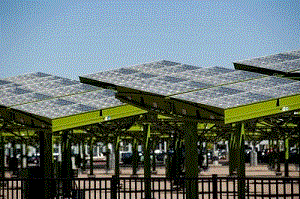Arizona Western College awarded for most distinct PV installation
 Last year Arizona Western College installed a 5-megawatt PV array—enough to offset more than 100 percent of its daytime energy use. In and of itself, not’s that special. But the project uses five different PV technologies, which is rather special, and was designed in such a way to allow the different systems to be compared directly against other PV technologies.
Last year Arizona Western College installed a 5-megawatt PV array—enough to offset more than 100 percent of its daytime energy use. In and of itself, not’s that special. But the project uses five different PV technologies, which is rather special, and was designed in such a way to allow the different systems to be compared directly against other PV technologies.
It’s that factor that led Solar Energy Industries Association (SEIA) and the Solar Electric Power Association (SEPA) to name it one of the most distinct PV projects of 2012.
“The award is really for the model of the 5 MW arrays,” said college spokesperson Lori Stofft. “This feels really wonderful. This was judged by an independent panel.”
The array has 1 MW of each of the five participants. GreenVolts Inc. and SolFocus provided high-concentrating PV arrays. Sharp provided a thin-film array on a tracker. SolarWorld provided monocrystalline PV and SunTech provided polycrystalline PV.
The project is owned by a Main Street Power subsidiary and under a 30-year power-purchase agreement with the college. The array is expected to save the college $62 million based on current electricity rates.
“What’s great is the productivity was higher than anticipated. One array is thin-film that’s tracking. Already the tracking has proven itself in the field,” Sofft said.
Many thin-film installations are mounted on fixed racking because they’re less expensive than silicon PV, and the trackers would make them more expensive to install. The college and GreenVolts have been pleased with the performance of the GreenVolt system, which may be the first time the company’s product was installed on such a large scale.
An important part of the project is making sure there’s transparency into how the different technologies are working. As such the school will introduce public monitoring to the system, according to Sofft. The system will show the public how each array stacks up to the competition.
The site also has extra test beds.
One is a nine bed and the other a 40 bed area, where solar manufacturers can bring their products and test them in the hot Arizona sun, Sofft said. That way they can compare them to the other arrays already installed at the site.



